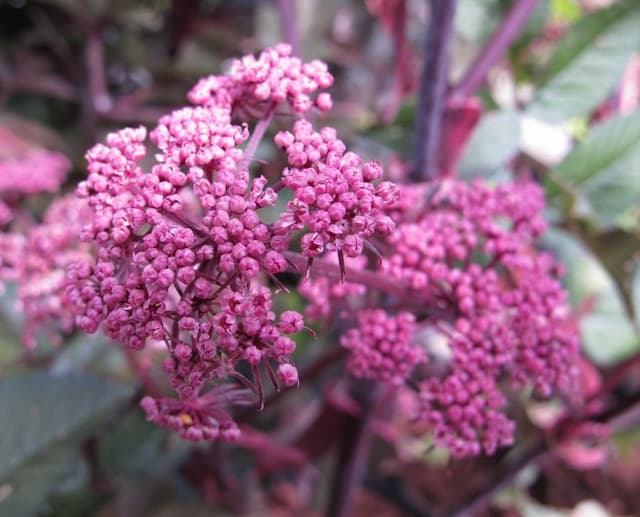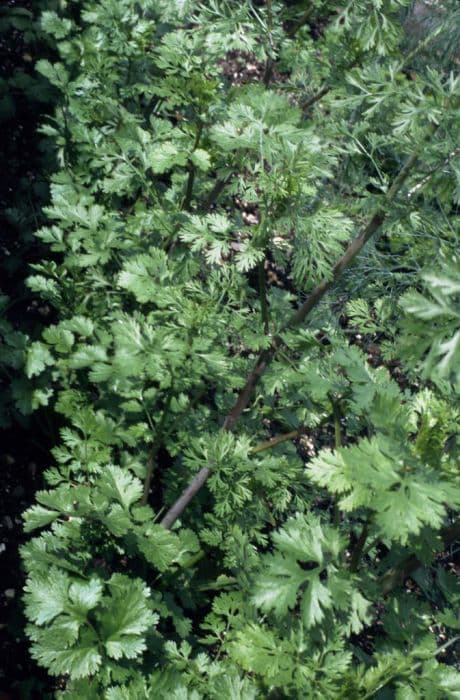Great Masterwort Astrantia major 'Alba'
ABOUT
The Astrantia major 'Alba', often referred to as the Great Masterwort, is a perennial garden plant known for its unique and delicate appearance. It exhibits a clump-forming habit with branching stems and palmately lobed, pointed leaves that are a fresh green in color. The leaves present a slightly serrated edge, adding to the fine texture of the foliage. The key attraction of the Great Masterwort is its floral display. The flowers are composed of a central dome of tiny, star-like flowers that are encircled by a ruff of papery bracts, giving the appearance of a singular, pincushion-like bloom. These flowers are primarily white, though they can carry a very subtle hint of green or pink. The intricate blossoms are borne atop the slender stems and create a frothy effect when they are in full bloom, which typically occurs in late spring through summer. The Great Masterwort is prized for its delicate flowers and the enchanting, lacy effect they contribute to the garden landscape. It is a favored choice for cottage gardens, border plantings, and as a complement to other perennials. Additionally, the blooms are long-lasting when cut and add an elegant touch to floral arrangements.
About this plant
 Names
NamesFamily
Apiaceae
Synonyms
Great Masterwort, Large Masterwort, White Masterwort
Common names
Astrantia major 'Alba'.
 Toxicity
ToxicityTo humans
Great Masterwort is not known to be toxic to humans. Ingesting any part of the plant is unlikely to cause poisoning or present adverse symptoms. However, as a general rule, it is advisable not to consume parts of ornamental plants unless they are known to be edible and safe for human consumption.
To pets
Great Masterwort is also not known to be toxic to pets. Ingesting this plant should not result in poisoning or adverse health effects in animals such as dogs and cats. Although it is considered non-toxic, monitoring your pets and preventing them from eating large quantities of any non-food plants is always a good precaution.
 Characteristics
CharacteristicsLife cycle
Perennials
Foliage type
Deciduous
Color of leaves
Green
Flower color
White
Height
2 feet (60 cm)
Spread
2 feet (60 cm)
Plant type
Herb
Hardiness zones
5
Native area
Europe
Benefits
 General Benefits
General Benefits- Ornamental Appeal: Astrantia major 'Alba', commonly known as Great Masterwort, features delicate white pincushion-like flowers that add aesthetic value to gardens and landscapes.
- Long Blooming Period: It has a lengthy flowering season from early summer to early autumn, providing extended visual interest.
- Attracts Pollinators: The flowers attract bees and butterflies, supporting local ecosystems and benefiting pollination for surrounding plants.
- Drought Tolerance: Once established, it exhibits good drought tolerance, making it suitable for gardens with lower water availability.
- Shade Tolerance: Great Masterwort can thrive in partial shade conditions, providing flexibility for gardeners with shaded areas.
- Low Maintenance: It requires minimal care once established, making it a good choice for gardeners who prefer low-maintenance landscapes.
- Deer Resistance: Great Masterwort is not a preferred plant for deer, which can reduce the likelihood of damage in areas with deer populations.
- Blends Well in Mixed Borders: Its understated elegance allows it to blend seamlessly with other perennials in mixed borders or cottage gardens.
- Cut Flower Use: The blooms make excellent cut flowers for arrangements, with a long vase life and unique form.
- Disease and Pest Resilience: The plant is generally resistant to diseases and pests, reducing the need for chemical treatments.
- Cold Hardy: It is cold hardy and can survive in colder climates, broadening the regions where it can be successfully grown.
 Medical Properties
Medical PropertiesThis plant is not used for medical purposes.
 Air-purifying Qualities
Air-purifying QualitiesThis plant is not specifically known for air purifying qualities.
 Other Uses
Other Uses- Astrantia major 'Alba', commonly known as Great Masterwort, can be used in dried flower arrangements due to its sturdy structure and ability to retain shape and color when dried.
- When crushed, the leaves of Great Masterwort can act as a natural insect repellent, making it useful in the garden for protecting other plants.
- The seed heads of Astrantia major 'Alba' can be added to potpourri mixes for visual interest and texture.
- Artists and crafters may use the intricate patterns of Great Masterwort flowers as inspiration for designs in jewelry, embroidery, or fabric prints.
- The geometric flower clusters of Great Masterwort can serve as educational tools in botanical studies to illustrate radial symmetry and plant structure.
- Astrantia major 'Alba' can be planted in outdoor maze designs in gardens, providing an aesthetic dimension with its striking blooms.
- The dense clumps formed by Great Masterwort are ideal for erosion control on slopes or areas prone to soil movement.
- Great Masterwort's foliage can be used as a subtle green filler in live floral arrangements, complementing more vibrant flowers.
- The flower's unique star-shaped bracts can be used in photography projects to add natural beauty and complexity to composed shots.
- Gardeners may use Great Masterwort planting as a natural way to delineate different sections of a garden without the need for fences or hardscaping.
Interesting Facts
 Feng Shui
Feng ShuiThe Great Masterwort is not used in Feng Shui practice.
 Zodiac Sign Compitability
Zodiac Sign CompitabilityThe Great Masterwort is not used in astrology practice.
 Plant Symbolism
Plant Symbolism- Perfection and Dexterity: Astrantia major 'Alba', commonly known as Great Masterwort, is often associated with perfection and dexterity due to its star-like bracts that form a delicate and intricate pattern, representing precision and skill.
- Mystery: The plant is also symbolic of mystery, as the small, pincushion-like flowers at the center of the bracts can be somewhat hidden and enigmatic.
- Protection: In some traditions, Great Masterwort is believed to symbolize protection, as it was once used in folk medicine to ward off evil spirits and disease.
- Unity: The clustered flowers of Astrantia major 'Alba' can represent unity and togetherness, as they grow tightly together, creating a strong visual impact.
- Everlasting Love: Due to its long-lasting flowers and durability, Great Masterwort may symbolize everlasting love, suggesting a bond that endures through time and challenge.
 Water
WaterGreat Masterwort requires consistent moisture, so it's important to water it regularly to maintain evenly moist soil, especially during dry spells. Typically, watering thoroughly once a week with about 1 to 1.5 inches of water is sufficient. However, during particularly hot or dry weeks, you may need to water twice a week to prevent the soil from drying out completely. It's best to water early in the morning or late in the afternoon to reduce evaporation. Applying mulch around the base of the plant can help retain soil moisture and reduce the need for frequent watering.
 Light
LightGreat Masterwort thrives in a location with partial shade or filtered sunlight. It prefers a spot that's sheltered from the hot afternoon sun, which can cause the leaves to scorch. Morning sunlight with afternoon shade is ideal for this plant as it encourages healthy growth without the stress of intense midday heat. It will also tolerate full sun in cooler climates, but always ensure the soil remains moist.
 Temperature
TemperatureGreat Masterwort grows best in a range of 64°F (18°C) to 75°F (24°C), which are considered ideal temperature conditions for this plant. It can withstand colder temperatures down to about 20°F (-6°C), making it a hardy perennial in many regions. While the plant is generally adaptable to temperature variations, it doesn't fare well in extreme heat, particularly if accompanied by drought conditions. Thus, providing shade and ample watering during hot spells is crucial.
 Pruning
PruningPruning Great Masterwort promotes a tidy growth habit and may encourage additional blooming. Deadheading or removing spent flowers throughout the blooming season can stimulate new blooms. After the main flowering period is over, cutting the plant back to the ground can help rejuvenate it for the next season. The best time for a more substantial prune is late winter or early spring before new growth begins.
 Cleaning
CleaningAs needed
 Soil
SoilGreat Masterwort prefers moist, well-drained soil rich in organic matter with a pH of 5.5 to 7.5. A mix incorporating garden loam, compost, and leaf mold is ideal.
 Repotting
RepottingGreat Masterwort doesn't require frequent repotting and can be done every 2-3 years or when the plant outgrows its container.
 Humidity & Misting
Humidity & MistingGreat Masterwort tolerates a wide range of humidity levels but thrives best with moderate to high humidity.
 Suitable locations
Suitable locationsIndoor
Place in bright, indirect light with moist, organic soil.
Outdoor
Partial shade, moist, fertile soil, good drainage is essential.
Hardiness zone
4-9 USDA
 Life cycle
Life cycleAstrantia major 'Alba', commonly known as Great Masterwort, begins its lifecycle as a seed that germinates in early spring under the right conditions of moisture and temperature. Once germinated, it develops a rosette of leaves at the soil surface, and establishes a strong root system. Over the growing season, the plant sends up stems and grows compound, palmate foliage that is bright green to dark green in color. By late spring to early summer, Great Masterwort produces umbels of small white flowers surrounded by bracts, giving a distinctive pincushion appearance that is very attractive to pollinators. After flowering, the plant sets seeds which can be dispersed by wind or harvested for propagation. As a perennial, Astrantia major 'Alba' dies back to the ground in the autumn with its root system surviving the winter, ready to regrow the following spring.
 Propogation
PropogationPropogation time
Spring to early summer
Propogation: The Great Masterwort, Astrantia major 'Alba', is commonly propagated through division, which is most effectively done in the spring. This involves carefully lifting the plant from the ground and gently separating the clump into smaller portions, each with several shoots and a healthy amount of root attached. These individual divisions can then be replanted into well-prepared soil, rich in organic matter, ensuring that the crowns are set at the same level as they were in the original planting. It's important to keep the newly planted divisions well-watered, especially during their first growing season, to establish a strong root system. Dividing the plants every few years also helps to rejuvenate them and maintain their vigor.








